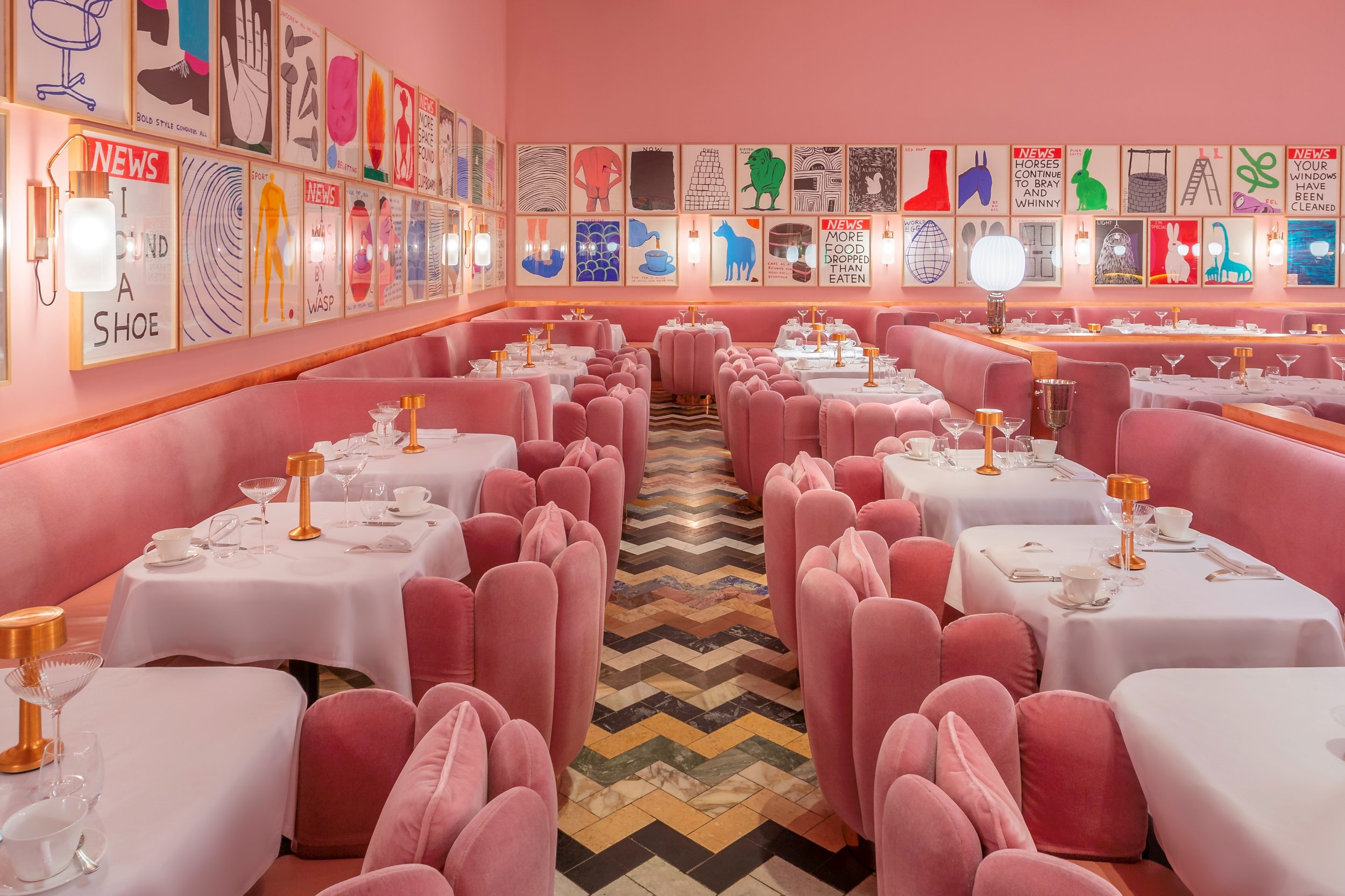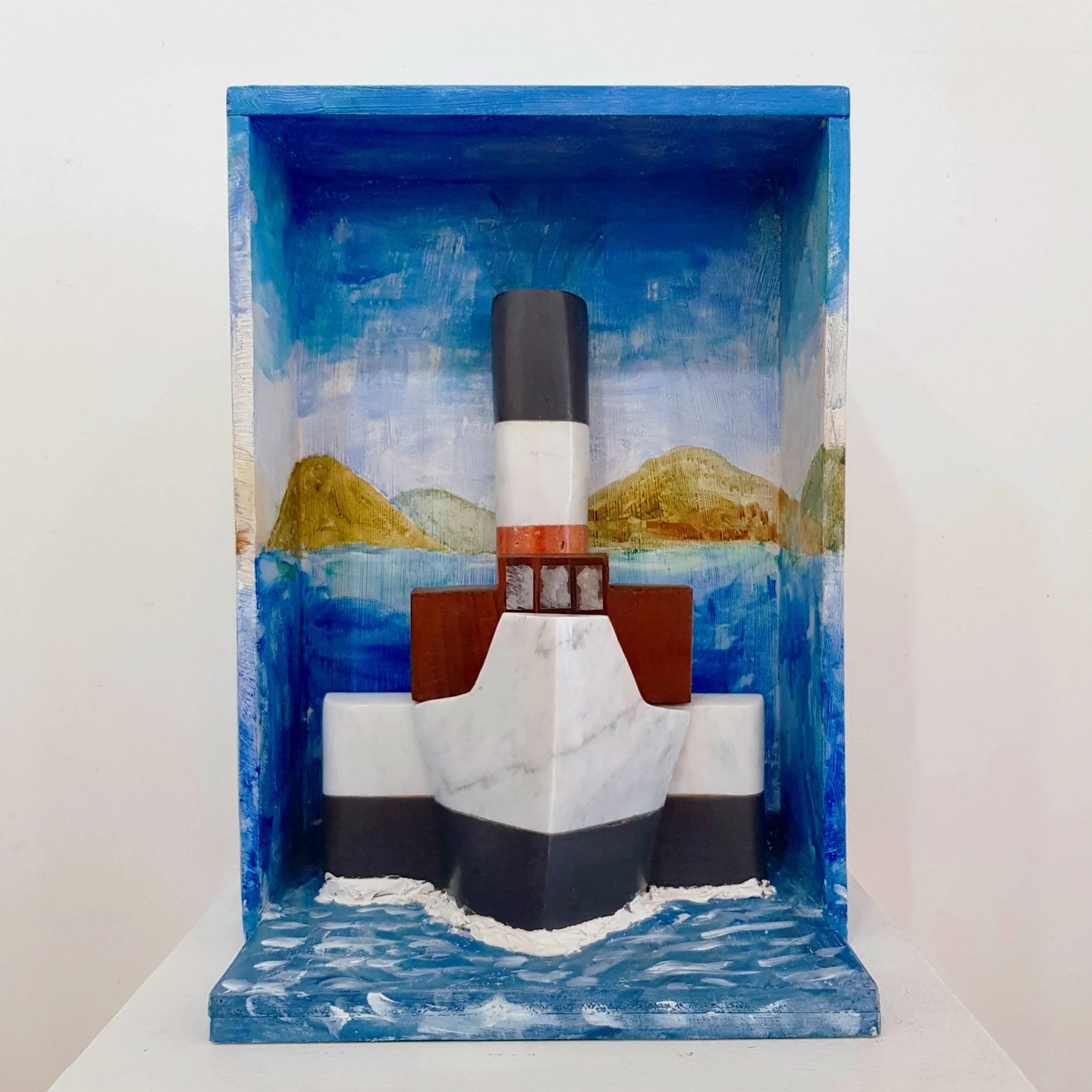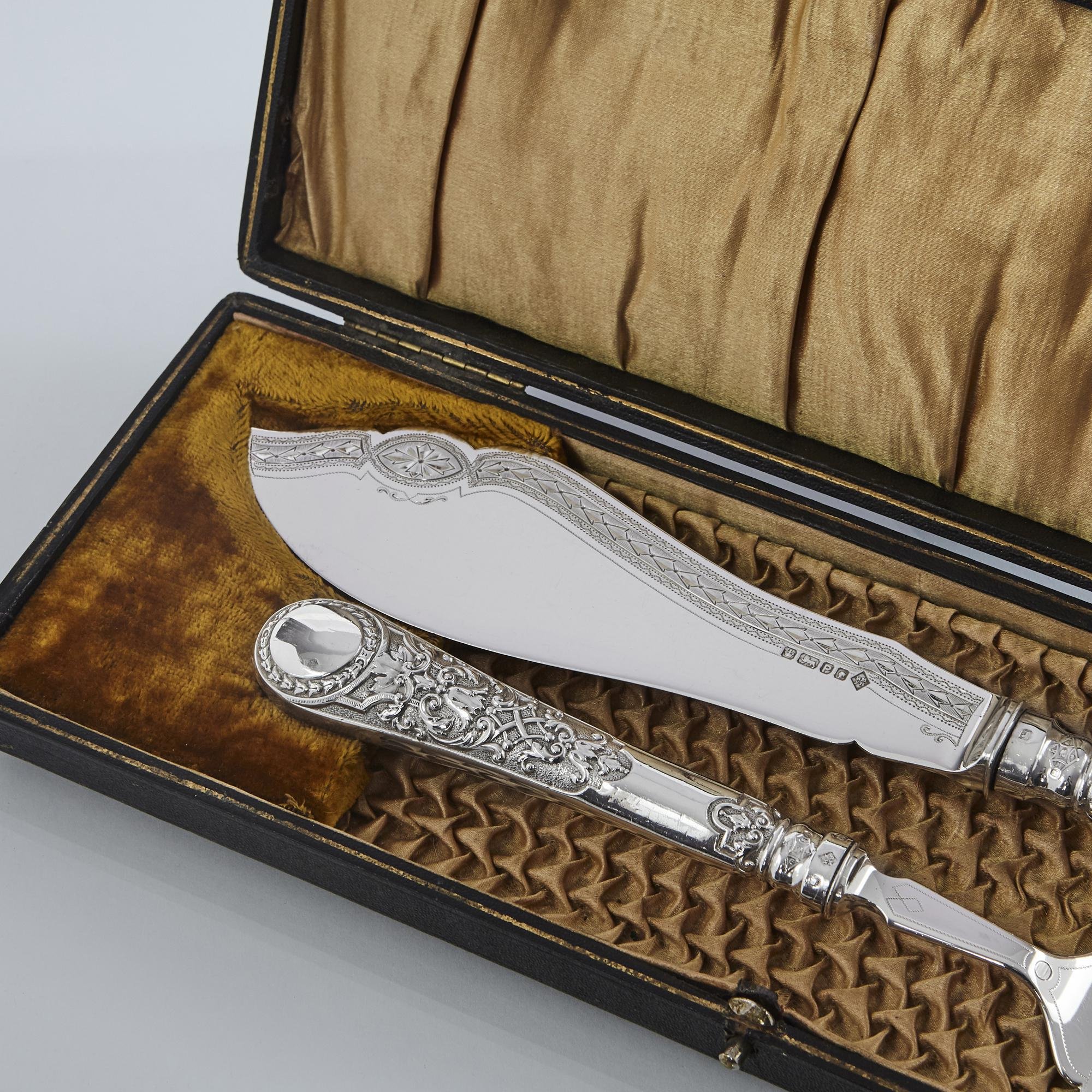Art for Eating
7 July 2022
Art good enough to eat? Or art to encourage just one more bottle?
Elise Bell
Elise Bell is an arts writer and commentator with bylines in The Independent, Elephant Magazine, The Guardian, Dazed and more.
Have you ever been to Sketch?
I haven’t, but it’s almost like I have.
Re-designed by David Shrigley back in 2014, some twelve years after its original opening date, Sketch tore up the rule-book of restaurant decor, ushering in the era of millennial pink just as Instagram started to boom. Capturing a new zeitgeist, where selfies, stories and tweets reigned supreme, Shrigley’s candy-floss interiors and caption-ready original 239 new works turned a high-end restaurant into something more than that: A fantasy; a dream factory; a site of pilgrimage. Teens in Shrimp coats posed in the toilets by chrome white egg pods, High Society ‘It Girls’ shared snaps of garishly pastel afternoon tea and celebrities drank coupes of champagne from plush velvet art-deco booths. Despite living four-hundred miles away in a mouse infested flat in Edinburgh, through an illuminated phone screen I became more intimately acquainted with the interiors of this restaurant than I did my own kitchen.
The ‘Pink Room’ at Sketch, designed by David Shrigley in 2014, with some of his 239 works on display.
The ‘Pink Room’ at Sketch, turned to yellow during the restaurant’s 2022 refurbishment, with art by Yinka Shonibare.
It felt like a turning point then, when in March 2022 it was revealed that Sketch had undergone a dramatic refurbishment, the sugar-pink walls transformed in hues of solar yellow and ochre; Shrigley’s irony-laden ‘state of the nation’ posters swapped for fourteen new site-specific artworks by Yinka Shonibare, CBE, grouped together under the title, Modern Magic. Under this new re-hang, parody was out and incisive commentary on cultural appropriation was in, Shonibare’s reimagining of the restaurant including collaborations with Dakar-based artist Aissa Dione as well as new additions to the menu: Yinka Rice (inspired by West African jollof rice) and Yinka Zobo (a cocktail of dark rum, pineapple liqueur and ginger beer). It signalled a shift not just in interior trends, but in the direction of the establishment itself, Sketch’s much publicised changing-of-the-guards emblematic of a radically different artworld to the one that existed almost a decade before, as well as the blurred lines between food and art.
This dynamic relationship between food and art, gallery and restaurant is not new. In London at least, the closest historical relative to Sketch can be found South of the river in Vauxhall.
“In the eighteenth century, if you wanted to see and be seen, Vauxhall Pleasure Gardens is where you would go” argues Danielle Thom, Curator of Making at the Museum of London. First open to the public in the 1730s, the gardens were a significant innovation in the capital’s nightlife and leisure scene, with members of the public either paying at the door or purchasing an annual season ticket to gain entry to the landscaped grounds, en-plein-air concerts and “highly modern” supper boxes that circuited the garden. “This entry system, where anyone who had the money and was reasonably well dressed could go into the gardens, means you had aristocracy rubbing shoulders with small-time merchants and petty bourgeoisie…It was also one of the first examples of the modern restaurant as we know it, where people ate communally for pleasure rather than necessity.” Unlike the chop-houses and taverns that provided food predominantly for male tradesmen, Vauxhall Pleasure Gardens provided an early iteration of “going out” for a meal, the menu including roast chicken, beef and ham as well as bread, butter, olives and salad. According to Thom, the gardens were also one of the early adopters of art in restaurants, with artists such as Francis Hayman creating pastoral moral scenes, “think shepherdesses and rustic youths dancing around a Maypole” she adds.
Tom and Jerry and Logic making the most of an Evening at Vauxhall: 1821. Etched by I.R. and G. Cruikshank.
Image courtesy of The Museum of London.
Designed to be gently amusing and instructive, these artworks were located in the supper boxes where guests would dine, providing observers the tantalising opportunity to watch others eat with the excuse of “admiring the artworks” behind them. It was also a canny business opportunity for proprietor and art-world patron Jonathan Tyers to promote his artists, elevating their social status and familiarising members of the affluent middle class with their work.
Speaking to me over zoom, ‘man about town’ and food writer Hugh Richard Wright is intimately acquainted with London’s dining scene. Pointing to one of Mayfair’s most high-end French Brasseries, Bellamy’s Restaurant boasts delights such as “iced lobster souffle” as well as an extensive collection of prints and illustrations by French fashion illustrator René Gruau. With Gruau prints typically priced between $1,500-$3,000, the value is indicative of Bellamy’s affluent reputation, with rumours abound that the restaurant is in fact her Majesty’s favourite. Yet for Hugh, the relationship between food and art is more meaningful. “With Bellamy’s, the art has been chosen for several reasons; it pairs the style and colour palette that feels familiar to a Brasserie, whilst also creating something beautiful that is designed to be a talking point."
Much like Tyers, other restaurant proprietors have often called in favours of artist friends, commissioning their works to entice diners. A short walk down from Bellamy’s, hospitality kingpin Richard Caring plans to open his latest venture: Bacchanalia. Already capturing headlines before it opens, Caring has commissioned close friend Damien Hirst to create a quartet of giant-sized works, including “winged lovers embracing on a unicorn.” Other artist collaborators include Tracey Emin who worked with Caring to create The Emin Room: a private dining room surrounded by original works of Emin and located at Caring’s hyper-exclusive 34 Mayfair.
Yet within the history of food and art, not all collaborations have run smoothly. In 1958, Rothko was commissioned by The Four Seasons Restaurant to create a set of bespoke works later known as the Seagram Murals. A year later, in a conversation with John Fischer, an editor of Harper’s Magazine, Rothko described how he intended his works to “upset, offend and torture” the diners of Manhattan’s glittering Four Seasons, with Fischer quoting Rothko as saying “I hope to ruin the appetite of every son of a bitch who ever eats in that room.” When eventually Rothko dined at the restaurant, his reaction was explosive. He returned every cent of his commission to The Four Seasons and had his canvases shipped into storage. The murals now hang at the Tate Modern.
Interior of Bellamy’s Restaurant, with prints by René Gruau.
Photograph by Sophie Ziegler.
Other artists have embraced the link between art and food more readily, playing with the boundaries between dining spaces and gallery spaces. In 1992, Rirkrit Tiravanijia emerged as a leading example of ‘relational aesthetics’, the Thai contemporary artist rejecting art objects and instead subverting traditional ideas of the gallery space by cooking and serving food for exhibition visitors at the Paula Allen Gallery in New York. Entitled Pad Thai, the work became part of a series known as Untitled (Free/Still), with Tiravanijia exploring how to create congenial social spaces within the codified and hierarchical art world. Gallery rooms normally adorned with contemporary art became make-shift kitchens and dining areas, the fragrant smell of jasmine rice and South-east Asian green curry wafting through the air as artists, curators and members of the public ate lunch with one another.
This community building aspect of restaurant art has been keenly felt in the eighteen months of the Covid-19 Pandemic. Soho’s French House - an institution amongst Londoners, in part because of its excellent cheap wine, eclectic crowd and history with Francis Bacon - was saved by a community of artists donating £65,000 worth of art in auction created to help the institution survive lockdown. Artists involved included Vivienne Westwood, Gilbert and George, Joe Hesketh and Keith Haring.
“Fundamentally, artists have always loved restaurants and restaurants have always loved artists.” says Hugh. “It’s about creativity. There are chefs who would consider themselves artists, especially as so much of food is about the visual. If you can choose art that can create a beautiful sense of place, it adds to the whole experience.”
Though my pockets don’t stretch to accommodate a Thursday night dinner at Sketch or a weekend table in Mayfair, I was once able to go with a friend to Dory’s in Margate. Tucked on a narrow street off the immediate beach front, we ate small-plates of rock oysters, pickled herring and steamed mussels in a cider ramson sauce. Mounted on the walls and framed in copper cabinets were shrimp, octopus and crab, set in coloured resin and taxidermied to look like they were floating in a sea of technicolour. Created by artist Harriet Horton, each work looked like they belonged to the space, in a strange harmony with the food we were eating. It was the best meal of my life.

































